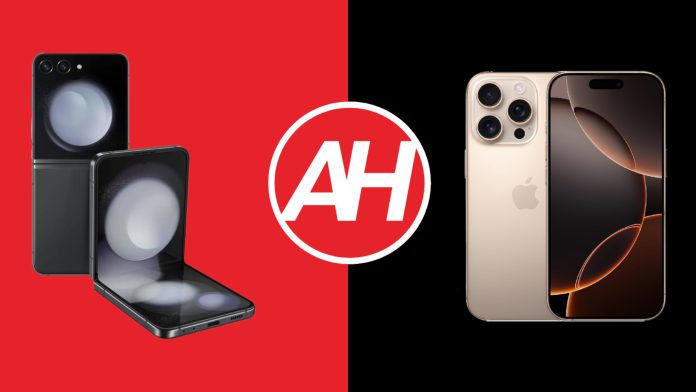This time around, we’ll be comparing Samsung’s best flip phone foldable with the best iPhone Apple has to offer in general. In other words, this is a Samsung Galaxy Z Flip 7 vs Apple iPhone 16 Pro Max comparison. The iPhone 16 Pro Max is a non-foldable smartphone, of course. These two phones are vastly different, which should make this comparison even more interesting, actually.
We’ll kick things off by listing the specs of both phones. Following that, we’ll compare their designs, displays, performance, battery life, cameras, and audio output. There are very few similarities between these two phones, actually. They’re as different as they can be, more or less. In any case, let’s get to it, shall we?
Specs

Samsung Galaxy Z Flip 7

Apple iPhone 16 Pro Max
| Samsung Galaxy Z Flip 7 | Apple iPhone 16 Pro Max | |
|---|---|---|
| Dimensions (unfolded/folded) | 166.7 x 75.2 x 6.5 mm / 85.5 x 75.2 x 13.7 mm | 163 x 77.6 x 8.3 mm |
| Weight | 188 grams | 227 grams |
| Main display | 6.9-inch Foldable Dynamic LTPO AMOLED 2X (120Hz) | 6.9-inch LTPO Super Retina XDR OLED (1-120Hz, adaptive) |
| Cover display | 4.1-inch Super AMOLED (120Hz) | N/A |
| Resolution | 2520 x 1080 / 1048 x 948 | 2868 x 1320 |
| Chipset | Samsung Exynos 2500 | Apple A18 Pro |
| RAM | 12GB (LPDDR5X) | 8GB |
| Storage | 256GB/512GB (UFS 4.0) | 256GB/512GB/1TB (NVMe) |
| Main camera | 50MP (f/1.8 aperture, 1/1.57-inch sensor size, dual pixel PDAF, OIS) | 48MP (wide, f/1.8 aperture, 1/1.28-inch sensor size, 1.22um pixel size, dual pixel PDAF, sensor-shift OIS) |
| Ultra-wide camera | 12MP (f/2.2 aperture, 1/3.2-inch sensor size, 123-degree FoV) | N/A |
| (Periscope) telephoto camera | N/A | 10MP (f/2.4 aperture, 1/3.52-inch sensor size, 1.12um pixel size, PDAF, OIS, 3x optical zoom) |
| Selfie camera | 10MP (f/2.2 aperture, 1/3.0-inch sensor size, 1.22um pixel size) | 12MP (f/1.9 aperture, 1/3.6-inch sensor size, 1.0um pixel size, PDAF, OIS) |
| Battery size | 4,300mAh | 4,685mAh |
| Charging | 25W wired, 15W wireless, 4.5W reverse wireless (charger not included) | 38W wired, 25W MagSafe wireless, 15W Qi2 wireless (charger not included) |
| Colors | Blue Shadow, Jet Black, Coral Red | Black Titanium, White Titanium, Natural Titanium, Desert Titanium |
Samsung Galaxy Z Flip 7 vs Apple iPhone 16 Pro Max: Design
Both of these smartphones have rounded corners and flat sides, including front and back sides, plus their frames. That’s basically where similarities end, though. The Galaxy Z Flip 7 has an aluminum frame, with a bit of titanium in the hinge, and glass on its back. The iPhone 16 Pro Max comes with a frame made out of titanium, with a bit of aluminum thrown in there. It also has glass on the back, but a different kind of glass.
The Galaxy Z Flip 7 has a centered display camera hole on its main (foldable) display. The iPhone 16 Pro Max includes a pill-shaped cutout, which is also centered, it’s the so-called Dynamic Island. Samsung’s phone includes power/lock and volume up and down keys on the right-hand side. The power key also doubles as a fingerprint scanner. The iPhone 16 Pro Max has a power/lock key on the right-hand side, along with the Camera Control. On the left, you’ll find the volume keys and an Action Key.
If we flip them around, you’ll see even more differences. The Samsung Galaxy Z Flip 7 includes its cover display there, which covers roughly half of the phone’s back side (when unfolded). Two horizontally aligned cameras are included inside that display, in the top-left corner. In that same spot, the iPhone 16 Pro Max has its triple camera setup, though a second display is not included there, of course.
Samsung’s foldable is IP48 certified for water and dust resistance. The iPhone 16 Pro Max comes with an IP68 certification for water and dust resistance. When unfolded, the Galaxy Z Flip 7 is taller, narrower, and thinner than the iPhone 16 Pro Max. It is also considerably lighter, by 39 grams.
Samsung Galaxy Z Flip 7 vs Apple iPhone 16 Pro Max: Display
The Samsung Galaxy Z Flip 7 features a 6.9-inch Foldable Dynamic LTPO AMOLED 2X display. That panel offers an adaptive refresh rate (1-120Hz) and supports HDR10+ content. The peak brightness is 2,600 nits, while the screen-to-body ratio is around 88%. The display aspect ratio is 21:9, while the resolution is 2520 x 1080. The cover display measures 4.1 inches, and it’s a Super AMOLED panel. It has a refresh rate of 120Hz, while the peak brightness here is 2,600 nits. The resolution you’re getting is 1048 x 948, while this panel is protected by the Gorilla Glass Victus 2.

The iPhone 16 Pro Max, on the flip side, has a 6.9-inch LTPO Super Retina XDR OLED display. That panel has an adaptive refresh rate of up to 120Hz. HDR10 content is supported, and the same goes for Dolby Vision. This panel is flat, and it has a peak brightness of 2,000 nits. The screen-to-body ratio is at around 91%, while the display aspect ratio is 19.5:9. The resolution on offer is 2868 x 1320, while the Ceramic Shield glass (2024 edition) protects this panel.
All three displays here are really good, actually. There’s not much to complain about. They are all vivid, sharp, and have great viewing angles. The touch response is also quite good on all of them. The crease on the Galaxy Z Flip 7’s main display is not that noticeable either. They’re all bright enough when you need them to be, and the blacks are as deep as you’d expect them to be.
Samsung Galaxy Z Flip 7 vs Apple iPhone 16 Pro Max: Performance
Samsung’s foldable is fueled by the Samsung Exynos 2500 processor, a 3nm chip from the company. That chip is paired with 12GB of LPDDR5X RAM and UFS 4.0 flash storage. The Apple A18 Pro fuels the iPhone 16 Pro Max, Apple’s most powerful chip to date. That’s also a 3nm processor. It is paired with 8GB of RAM inside this phone, while Apple utilizes NVMe flash storage. Neither phone supports storage expansion.
Both of these phones offer great performance. The iPhone 16 Pro Max has a more powerful processor, but both of them are very snappy in day-to-day use. They can open apps really fast, jump between them, handle multimedia, and so on. There are no problems whatsoever in that regard.
What about gaming? Well, the iPhone 16 Pro Max is better equipped to handle demanding games, in all honesty. Not only is the chip itself more powerful, but it has a more powerful GPU. Still, the Galaxy Z Flip 7 is nothing to scoff at in that regard. You can also play basically anything you set your mind to from the Google Play Store. The phone will handle it very well, at least the games that we’ve tried. Both smartphones do get quite warm during gaming, but we didn’t have issues with overheating or anything like that.
Samsung Galaxy Z Flip 7 vs Apple iPhone 16 Pro Max: Battery
There is a 4,300mAh battery included inside the Galaxy Z Flip 7. The iPhone 16 Pro Max, on the flip side, has a 4,685mAh battery. That 4,300mAh unit is not particularly large for the Galaxy Z Flip 7. Also, iPhones usually have smaller battery packs than their Android counterparts. That unit inside the iPhone 16 Pro Max is actually quite large, considering that this is a large-format iPhone we’re talking about.
Yes, there is a battery life difference, a considerable one. The Galaxy Z Flip 7 offers good battery life, but not great. Getting over 6 hours of screen-on-time was not an issue for us, we even managed to cross the 7-hour mark a couple of times. If you’re pushing the phone a bit harder, don’t expect to get to that level, though. The iPhone 16 Pro Max, on the other hand, can go above and beyond that. Add a couple of hours of screen-on time more to that, at least, and you’ll get the picture.
The Galaxy Z Flip 7 supports 25W wired, 15W wireless, and 4.5W reverse wireless charging. The iPhone 16 Pro Max, on the other hand, supports 38W wired, 25W MagSafe wireless, 15W Qi2 wireless, and 4.5W reverse wired charging. Despite the fact that the iPhone 16 Pro Max has a faster top charging speed, it does not use it at all times, not even close. The phone takes around 2 hours to fully charge, while the Galaxy Z Flip 7 can get there in an hour and a half. Neither phone offers particularly fast charging, nor do they ship with chargers.
Samsung Galaxy Z Flip 7 vs Apple iPhone 16 Pro Max: Cameras
Two cameras are included on the back of the Galaxy Z Flip 7. You’ll find a 50-megapixel main camera (1/1.57-inch sensor size), and a 12-megapixel ultrawide unit (1/3.2-inch sensor size, 123-degree FoV). Apple’s handset, on the other hand, has a 48-megapixel main camera (1/1.28-inch sensor size), a 48-megapixel ultrawide camera (1/2.55-inch sensor size), and a 12-megapixel periscope telephoto unit (1/3.06-inch sensor size, 5x optical zoom).

The iPhone 16 Pro Max offers better camera performance across the board, basically. While the Galaxy Z Flip 7’s main camera is not bad at all, we do prefer how the iPhone 16 Pro Max handles images a bit more. They’re closer to real life, and there’s also more detail there when you’re using the main camera. It also does a better job in low light. Something similar can be said for the ultrawide camera, actually, it also does a better job of keeping the same color profile as the main camera.
The Galaxy Z Flip 7 does not have a (periscope) telephoto camera at all. It relies on digital crop from the main snapper. The iPhone 16 Pro Max does include a periscope telephoto unit, and even though it’s not amongst the best in the market, it definitely beats the Galaxy Z Flip 7. Something is better than nothing, of course. If you plan on shooting photos in low light, we would recommend sticking to main cameras on both phones.
Audio
Both of these smartphones feature stereo speakers. The ones on the iPhone 16 Pro Max are noticeably louder, though. That’s something you’ll easily notice if you compare them side-by-side. Both sets are good enough in terms of loudness, though, and the same goes for the quality of the audio output.
There is no audio jack on either of these two smartphones. You can connect your wired headphones by using their Type-C ports, though. Alternatively, Bluetooth 5.4 is on offer by the Galaxy Z Flip 7, while the iPhone 16 Pro Max supports Bluetooth 5.3.
#Samsung #Galaxy #Flip #Apple #iPhone #Pro #Max

